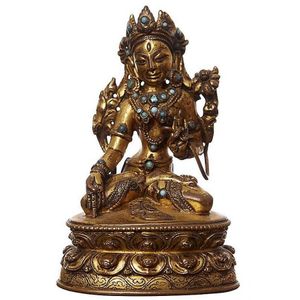Rare Tibetan Gilt-Bronze Figure of Amoghasidi, 15th Century
You must be a subscriber, and be logged in to view price and dealer details.
Subscribe Now to view actual auction price for this item
When you subscribe, you have the option of setting the currency in which to display prices to $Au, $US, $NZ or Stg.
- Lapis Lazuli - Lapis lazuli is a semi-precious deep blue coloured stone, sometimes with gold inclusions, that has been used for thousands of years for jewellery, decorative items and decoration.
It is mined in Afghanistan, Siberia, Chile, USA and Burma. The mines in north-eastern Afghanistan are the largest source of lapis lazuli, and have been operating for over 6,000 years.
They were the source of the stone for the ancient Egyptian, Greek and Roman civilsations. - Incised - A record of a name, date or inscription, or a decoration scratched into a surface, usually of a glass or ceramic item with a blunt instrument to make a coarse indentation. Compare with engraving where the surface is cut with a sharp instrument such as a metal needle or rotating tool to achieve a fine indentation.
- Malachite - Malachite is bright copper-green coloured stone with concentric layers which displays distinct contrasting veinings. It has been valued in the past for making or decorating small precious objects such as clocks, jewellery, dishes and so. In the Orient it was used for snuff bottles and in Russia and was favoured by the Faberge workshop. larger pieces were used for table tops.
The principal source of supply was Russia but it is to be found in other regions such as Southern Africa, Mexico, Australia and France.
Malachite glass is a manufactured material that was intended to resemble malachite, but often bears more resemblance to a veined coloured marble due to its lower gloss finish and lack of concentric layers. Malachite glass was manufactured by many glassworks in the 19th century including Loetz in Austria and others in Bohemia and Davidson's Greener's and Sowerby in north eastern England.
It was particularly used for scent bottles, bowls, and small vases often decorated with nymphs.
Malachite glass has been manufactured continuously since the late nineteenth century, most is unmarked and it is difficult to distinguish the age or manufacturer of most commercial pieces.
This item has been included into following indexes:
-
Oriental deities, bronze
- Amogahasidi 2
- Tibetan deities 132
- Oriental deities, Tibetan and Sino-Tibetan - Buddha and other deities 271
- oriental jewellery - necklaces 428
- oriental objects - rock crystal 109
Visually similar items

An old gilt bronze Bodhisattva, traditional seated pose with crossed legs and hands holding religious objects, upon a lotus throne, turquoise and other small cabochon stone highlights, most gilt finish remains, the high points showing old dark red/brown to

A Tibetan gilt bronze white Tara, 16th century, the fire-gilded bronze with turquoise inlay, the right hand in Bhumispharsha mudra and holding a lotus in the left, seated on a double lotus throne, with sealed base, 10.5 cm high. Provenance: Cito Cessna, Pa

A Chinese gilt bronze Buddha, double-vajra mark to the base, 28.7 cm high

A Chinese gilt-bronze seated figure of Amitayus, early Qing Dynasty, 17th/18th century. 16.8 cm high. Provenance: Apsara Antiques, 2008. A Sydney private collection
